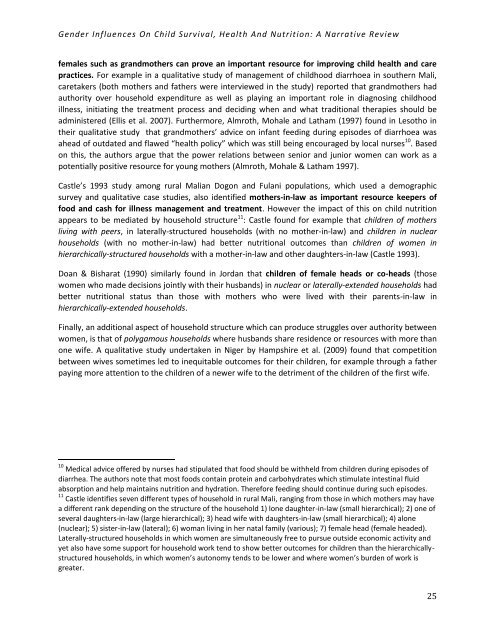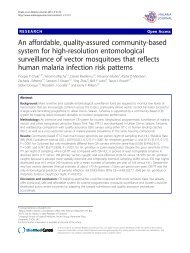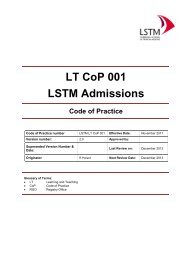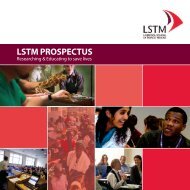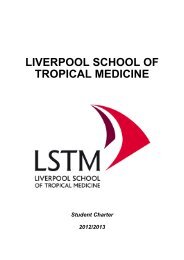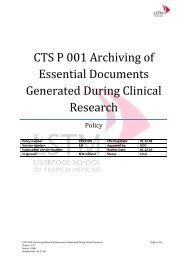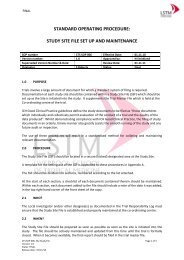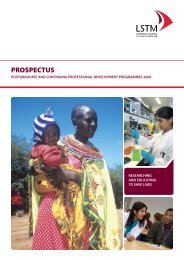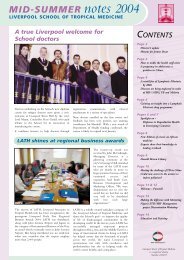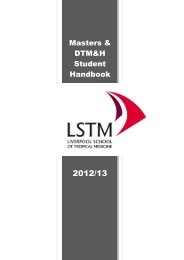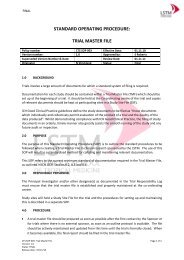Gender influences on child survival, health and nutrition: a ... - Unicef
Gender influences on child survival, health and nutrition: a ... - Unicef
Gender influences on child survival, health and nutrition: a ... - Unicef
Create successful ePaper yourself
Turn your PDF publications into a flip-book with our unique Google optimized e-Paper software.
<str<strong>on</strong>g>Gender</str<strong>on</strong>g> Influences On Child Survival, Health And Nutriti<strong>on</strong>: A Narrative Review<br />
females such as gr<strong>and</strong>mothers can prove an important resource for improving <strong>child</strong> <strong>health</strong> <strong>and</strong> care<br />
practices. For example in a qualitative study of management of <strong>child</strong>hood diarrhoea in southern Mali,<br />
caretakers (both mothers <strong>and</strong> fathers were interviewed in the study) reported that gr<strong>and</strong>mothers had<br />
authority over household expenditure as well as playing an important role in diagnosing <strong>child</strong>hood<br />
illness, initiating the treatment process <strong>and</strong> deciding when <strong>and</strong> what traditi<strong>on</strong>al therapies should be<br />
administered (Ellis et al. 2007). Furthermore, Almroth, Mohale <strong>and</strong> Latham (1997) found in Lesotho in<br />
their qualitative study that gr<strong>and</strong>mothers’ advice <strong>on</strong> infant feeding during episodes of diarrhoea was<br />
ahead of outdated <strong>and</strong> flawed “<strong>health</strong> policy” which was still being encouraged by local nurses 10 . Based<br />
<strong>on</strong> this, the authors argue that the power relati<strong>on</strong>s between senior <strong>and</strong> junior women can work as a<br />
potentially positive resource for young mothers (Almroth, Mohale & Latham 1997).<br />
Castle’s 1993 study am<strong>on</strong>g rural Malian Dog<strong>on</strong> <strong>and</strong> Fulani populati<strong>on</strong>s, which used a demographic<br />
survey <strong>and</strong> qualitative case studies, also identified mothers-in-law as important resource keepers of<br />
food <strong>and</strong> cash for illness management <strong>and</strong> treatment. However the impact of this <strong>on</strong> <strong>child</strong> nutriti<strong>on</strong><br />
appears to be mediated by household structure 11 : Castle found for example that <strong>child</strong>ren of mothers<br />
living with peers, in laterally-structured households (with no mother-in-law) <strong>and</strong> <strong>child</strong>ren in nuclear<br />
households (with no mother-in-law) had better nutriti<strong>on</strong>al outcomes than <strong>child</strong>ren of women in<br />
hierarchically-structured households with a mother-in-law <strong>and</strong> other daughters-in-law (Castle 1993).<br />
Doan & Bisharat (1990) similarly found in Jordan that <strong>child</strong>ren of female heads or co-heads (those<br />
women who made decisi<strong>on</strong>s jointly with their husb<strong>and</strong>s) in nuclear or laterally-extended households had<br />
better nutriti<strong>on</strong>al status than those with mothers who were lived with their parents-in-law in<br />
hierarchically-extended households.<br />
Finally, an additi<strong>on</strong>al aspect of household structure which can produce struggles over authority between<br />
women, is that of polygamous households where husb<strong>and</strong>s share residence or resources with more than<br />
<strong>on</strong>e wife. A qualitative study undertaken in Niger by Hampshire et al. (2009) found that competiti<strong>on</strong><br />
between wives sometimes led to inequitable outcomes for their <strong>child</strong>ren, for example through a father<br />
paying more attenti<strong>on</strong> to the <strong>child</strong>ren of a newer wife to the detriment of the <strong>child</strong>ren of the first wife.<br />
10 Medical advice offered by nurses had stipulated that food should be withheld from <strong>child</strong>ren during episodes of<br />
diarrhea. The authors note that most foods c<strong>on</strong>tain protein <strong>and</strong> carbohydrates which stimulate intestinal fluid<br />
absorpti<strong>on</strong> <strong>and</strong> help maintains nutriti<strong>on</strong> <strong>and</strong> hydrati<strong>on</strong>. Therefore feeding should c<strong>on</strong>tinue during such episodes.<br />
11 Castle identifies seven different types of household in rural Mali, ranging from those in which mothers may have<br />
a different rank depending <strong>on</strong> the structure of the household 1) l<strong>on</strong>e daughter-in-law (small hierarchical); 2) <strong>on</strong>e of<br />
several daughters-in-law (large hierarchical); 3) head wife with daughters-in-law (small hierarchical); 4) al<strong>on</strong>e<br />
(nuclear); 5) sister-in-law (lateral); 6) woman living in her natal family (various); 7) female head (female headed).<br />
Laterally-structured households in which women are simultaneously free to pursue outside ec<strong>on</strong>omic activity <strong>and</strong><br />
yet also have some support for household work tend to show better outcomes for <strong>child</strong>ren than the hierarchicallystructured<br />
households, in which women’s aut<strong>on</strong>omy tends to be lower <strong>and</strong> where women’s burden of work is<br />
greater.<br />
25


